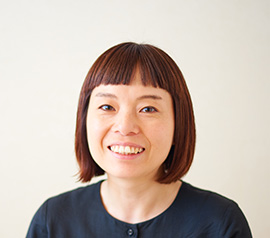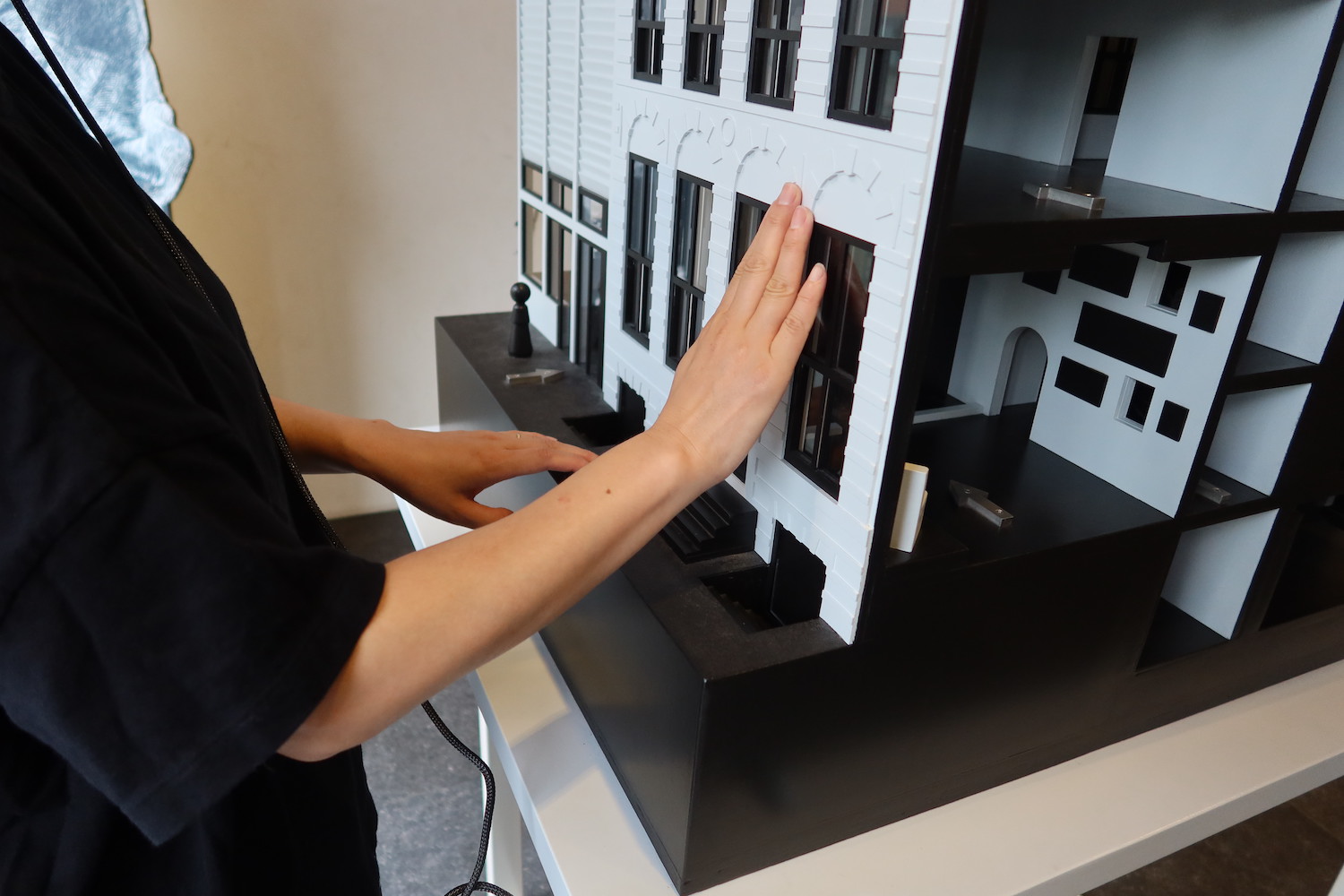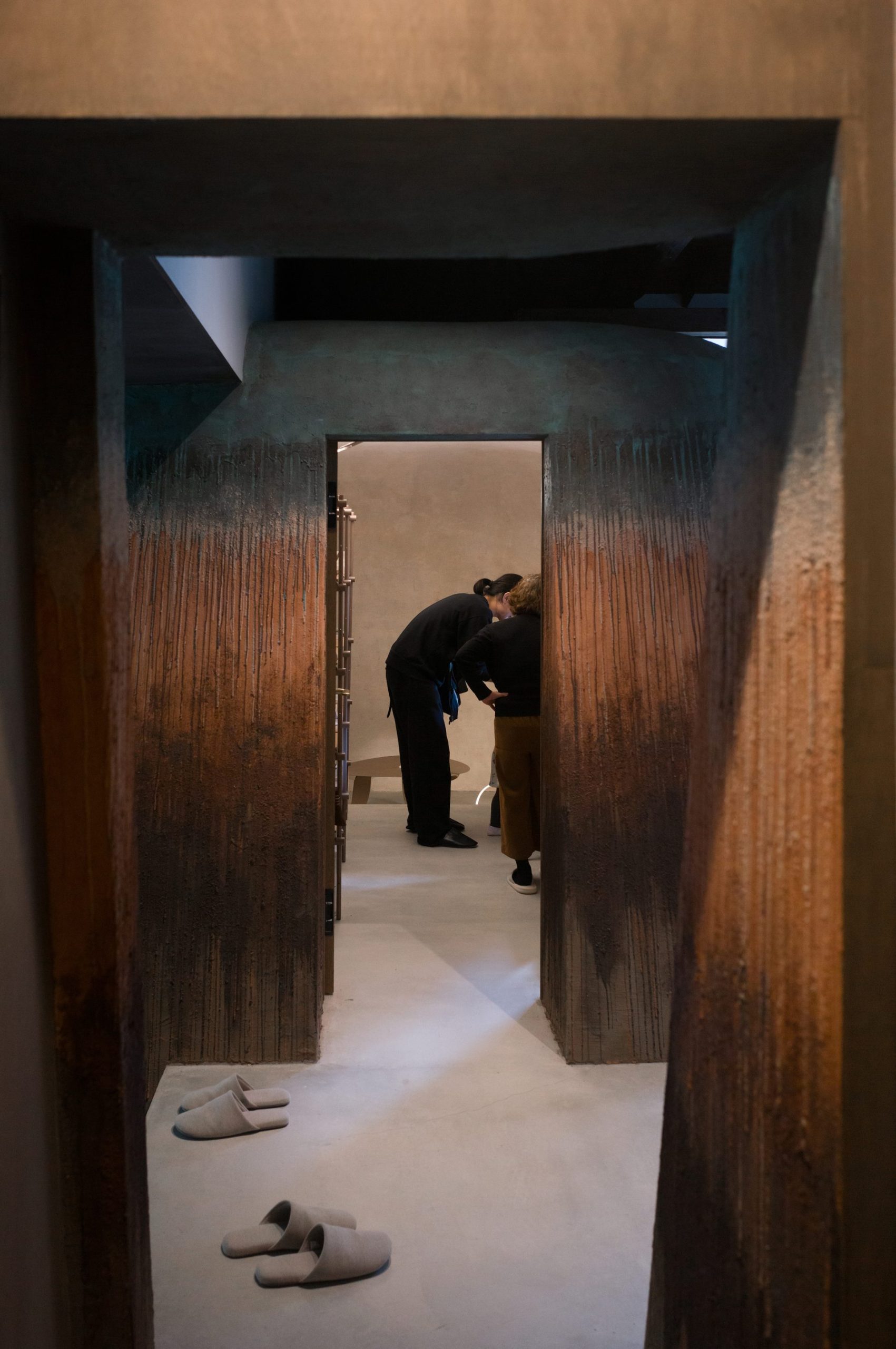Between 2023 and 2024, architectural models for the visually impaired have been installed in three museums in Amsterdam, the Netherlands. The main person behind the production is Hannes Wallrafen, who, since losing his eyesight 20 years ago, has focused on creating architectural models and museum programmes for the visually impaired. This report provides a Dutch case study on improving museum accessibility through the involvement of a disabled person.
‘Audio Architectural Model’ floor guide for the visually impaired
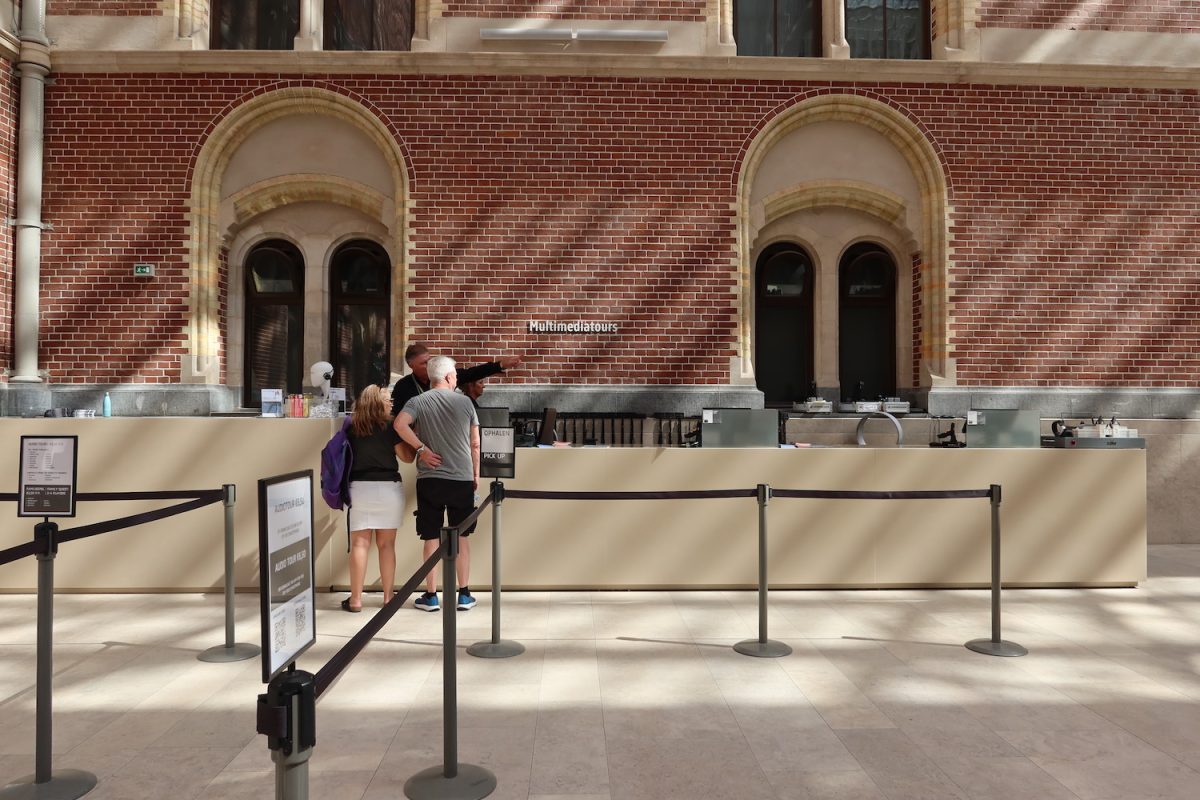 Architectural model (far right) at the multimedia tour desk in the Rijksmuseum [photo by the author]
Architectural model (far right) at the multimedia tour desk in the Rijksmuseum [photo by the author]
In June 2024, an architectural model for visually impaired visitors was permanently installed at the Rijksmuseum in Amsterdam (the National Museum of the Netherlands). The actual building is brick-coloured, but the model is white and grey, as the colour contrast makes it easier for people with low vision or colour blindness to recognise the architectural features. To use the model, the staff will tell you to put on the headphones provided, and press the button on the front. The audio is bilingual (Dutch and English). Following the instructions, you place your hand on a plate in the shape of the building, and hear general information related to floors and directions. From three-dimensional design of the model and your actual position in the building, you get an overview of the facility’s features. The model that Hannes Wallrafen created is named the ‘audio model’. It is crucial to gain information not only from the hands but also from the ears.
 Audio model of the Rijksmuseum. When touching the silver plate at the front, shaped like the actual building, the audio guide explains the building’s layout and directions.[Photo: Reinier Gerritsen]
Audio model of the Rijksmuseum. When touching the silver plate at the front, shaped like the actual building, the audio guide explains the building’s layout and directions.[Photo: Reinier Gerritsen]
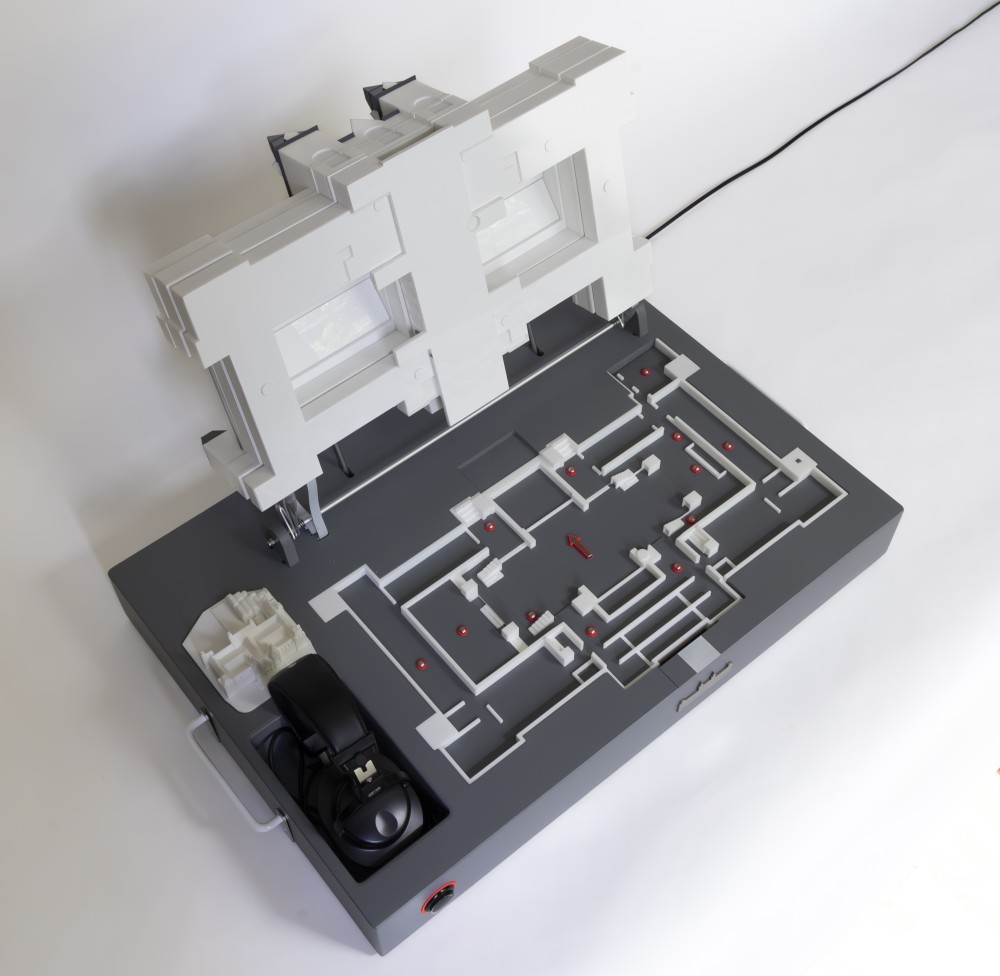 View of the model when opened. On the left are headphones and a hand-sized miniature of the museum. Touching the red buttons and arrows in the right part of the model starts an audio guide with detailed information on exhibition halls and layouts. [Photo: Reinier Gerritsen]
View of the model when opened. On the left are headphones and a hand-sized miniature of the museum. Touching the red buttons and arrows in the right part of the model starts an audio guide with detailed information on exhibition halls and layouts. [Photo: Reinier Gerritsen]
More detailed audio descriptions of the facility, such as locations of exits, information about representative works in each exhibition room, and their respective production years, can be obtained by touching the round buttons and arrows in the model. The most notable feature is a mechanism that allows each floor to be opened and closed vertically. By placing your hands on the top, you can examine the shape and layout of each floor. This is an essential point for a big museum with subdivided exhibition rooms like the Rijksmuseum.
The main reason why the Rijksmuseum promoted the creation of the model, was to enable visually impaired visitors to visit the museum without an assistant. Accessibility Manager Cathelijne Denekamp considered that such visitors would need two types of information to reach their destination independently: an overview of the facility, and navigation to each destination in it. For directions, a navigation app called eZwayZ®︎ is already in operation. The smartphone app can determine the current location, and navigate users through the museum by voice. As a preliminary step, however, Denekamp understood that a tool was needed to present an overall picture of the facility. Therefore, she commissioned Geluid in Zicht (Sound in Sight), headed by Wallrafen, to make an architectural model. The aim was to use the model in combination with the app, to enable independent visits by the visually impaired.
The audio model’s most unique feature is the inclusion of environmental sounds. Behind the descriptions, visitors’ voices and footsteps echoing in the museum are heard, just as they would be in the actual location. Each audio clip is 45 seconds or shorter, in order to convey the information clearly, while the environmental sounds broaden the user’s imagination of the place, and add a three-dimensional quality to the information. Personally, I enjoy museums not only by looking at the artworks, but also by indulging in the atmosphere inside the museum, and by observing other visitors. The audio model incorporates all those other attractions of museums besides looking at artworks.
Different models for different museums
Geluid in Zicht were so far involved in the production of three museum models. In addition to the Rijksmuseum, their models were permanently installed at the Rembrandt House Museum, established in the house where Rembrandt used to live, and the Amsterdam Architecture Centre (hereafter “Arcam”), which exhibits materials related to urban planning and architecture in Amsterdam. Each model has different features, reflecting the characteristics and requirements of each museum.
The Rembrandt House consists of the old wing and an adjoining new wing. The differences between the two wings are emphasised in the model and its audio guide, which helps first-time visitors to grasp the complex route and layout. The museum is unique because Rembrandt, his family and his pupils actually lived and worked here. The sizes, heights and fittings of each room varied according to its functions and the person(s) who used it. This is reflected in the model, making us feel as if following the path of the 17th-century painter through our fingertips and ears.
 Audio model of the Rembrandt House Museum [photo by the author]
Audio model of the Rembrandt House Museum [photo by the author]
 Examining the building’s front on the audio model [photo by the author]
Examining the building’s front on the audio model [photo by the author]
Arcam is located in a former shipyard area. From its floor-to-ceiling glass windows, visitors can see the National Maritime Museum, the NEMO Science Museum, and boats on the canals. Wallrafen believed that, introducing not only the museum but also its surroundings, would provide more comprehensive information, so a model was created that includes the neighbourhood. By following the arrows on the model, starting from the Arcam building, you can “walk” around the museum like you would do in reality. In addition, the materials in the model vary according to the categories “water,” “green spaces” and “artificial structures,” allowing you to discern the different environments by touch. Environmental sounds are of course also included. The sounds of boats, swimmers in the water, and sirens signaling the raising and lowering of the drawbridge, characterise each location.
 Audio model of Arcam [Photo: Studio KU+]
Audio model of Arcam [Photo: Studio KU+]
 Model of the “Oosterdok” area around Arcam [photo by the author]
Model of the “Oosterdok” area around Arcam [photo by the author]
Furthermore, the ways in which visually impaired visitors can view works and obtain information on the exhibition rooms, vary from museum to museum. For the Rijksmuseum, the above-mentioned eZwayZ® app provides visitors with explanations of the main collection. Special exhibitions are not currently supported, but will be added to the app in the future. In addition, the museum offers actual guided tours for the visually impaired, which introduce special exhibitions and the main collections. In the Rembrandt House, visitors can touch or smell actual objects such as shells that Rembrandt used as a motif in his paintings, and a reproduction of his palette. Arcam will provide the full exhibition texts on its website in the future, so that visitors can use the read-out function on their own smartphones and computers.
From “Photo”grapher to “Audio”grapher
So how did Wallrafen get involved in making models for the visually impaired? After graduating from Gerrit Rietveld Academie in Amsterdam, he became a documentary photographer who provided magazine publishers with photos and texts from conflict zones such as Iran and Northern Ireland. The change came in 2004, at the age of 52. “When I sat in my studio, the windows gradually became invisible. Then, soon after, the bricks of the building disappeared as well”. The vision loss, caused by a hereditary disease, deteriorated within just four months to the point where he could only distinguish between light and dark. While losing eyesight, he travelled to the Caribbean island of Curaçao, and worked on field recordings instead of taking photographs. “From that moment on, I became an ‘audio’grapher rather than a ‘photo’grapher”. The fact that environmental sounds are an integral part of his architectural models, results from this turning point in his life.
 Hannes Wallrafen [Photo: Studio KU+]
Hannes Wallrafen [Photo: Studio KU+]
Four years after losing his eyesight, he came up with the idea of making architectural models for the visually impaired. It all started with an event in a concert hall. “When I went to a concert, a friend described the hall’s layout. Later, when I visited the place again with another friend, the description was completely different”. The idea for the model was inspired by friends’ descriptions of the same building from different angles, and from realising the possibilities of sound through field recordings.
The audio model project eventually started with the National Parliament building. Wallrafen assumed that, although many visually impaired people listen to parliamentary broadcasts on the radio, few would know the interior of the building. Two obstacles—financial and technical—stood in his way. However, with grants from several visually impaired organisations, and the involvement of graduate students majoring in architecture, the project was completed six years after his initial idea. This work led to commissions from the museums mentioned above.
Architectural models for “use” made in collaboration with a visually impaired person
For the production, the Amsterdam-based architectural modeller Kaita Shinagawa (director of Studio KU+) joined the Rijksmuseum and Arcam project team. Even for a professional like Shinagawa, tactile-architectural models were entirely different from his previous work. Generally, architectural models are made to imagine a building to be built in the future, or to present an overall view of a completed building. However, Wallrafen’s audio models have to be produced with the idea in mind that people will touch them. The function changes from “to be shown” to “to be used”. Especially in terms of durability, a different perspective from previous experiences is required. Shinagawa and Wallrafen turned their ideas into reality by exchanging thoughts weekly, from the overall size down to details. “It was essential for this project that he was a visually impaired person”, Shinagawa recalled. The whole production process is Wallrafen’s initiative. Whenever a museum commissions a project, a team of architects, architectural modellers and audio specialists is assembled. Wallrafen then acts as a mediator between the museum and the production team, while integrating with both sides, so that the models can reflect the views of the visually impaired.
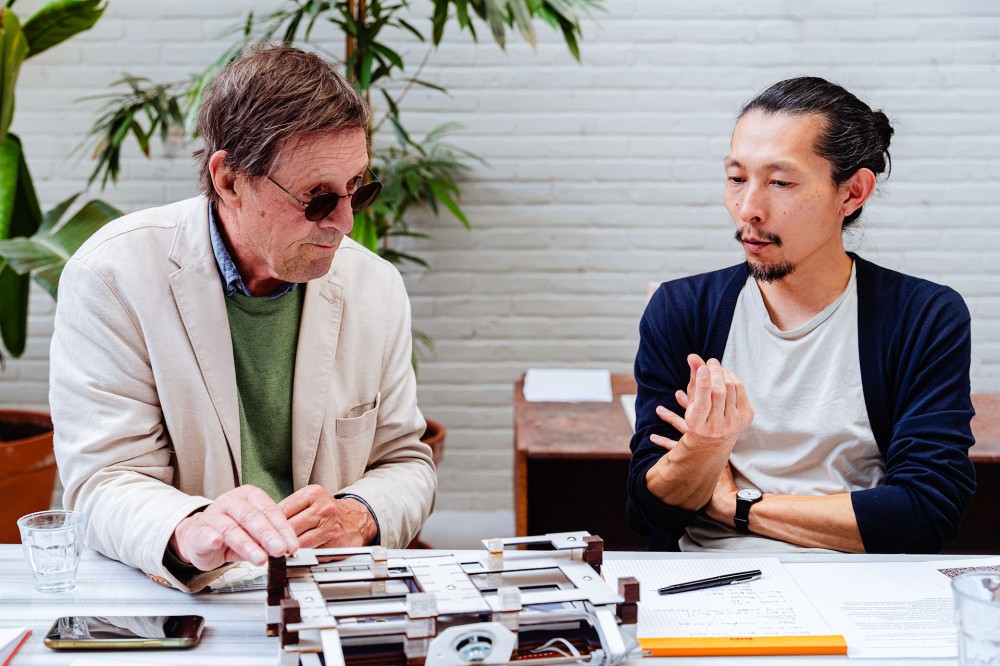 Hannes Wallrafen (left) and Kaita Shinagawa [Photo: Studio KU+]
Hannes Wallrafen (left) and Kaita Shinagawa [Photo: Studio KU+]
In conclusion, in order to encourage people with disabilities to visit a museum, an attitude of collaborating with them, and involving them in the decision-making process, is crucial. Those directly affected know better than anyone else what circumstances or needs they may encounter in a museum. This project is valuable because it focuses on accessibility from the perspective of people with disabilities, and brings those ideas to reality. Based on his own experience, Wallrafen firmly believes that “museums and art make one’s life richer”. Therefore, he desires to create an environment where other visually impaired people can visit museums quite normally.
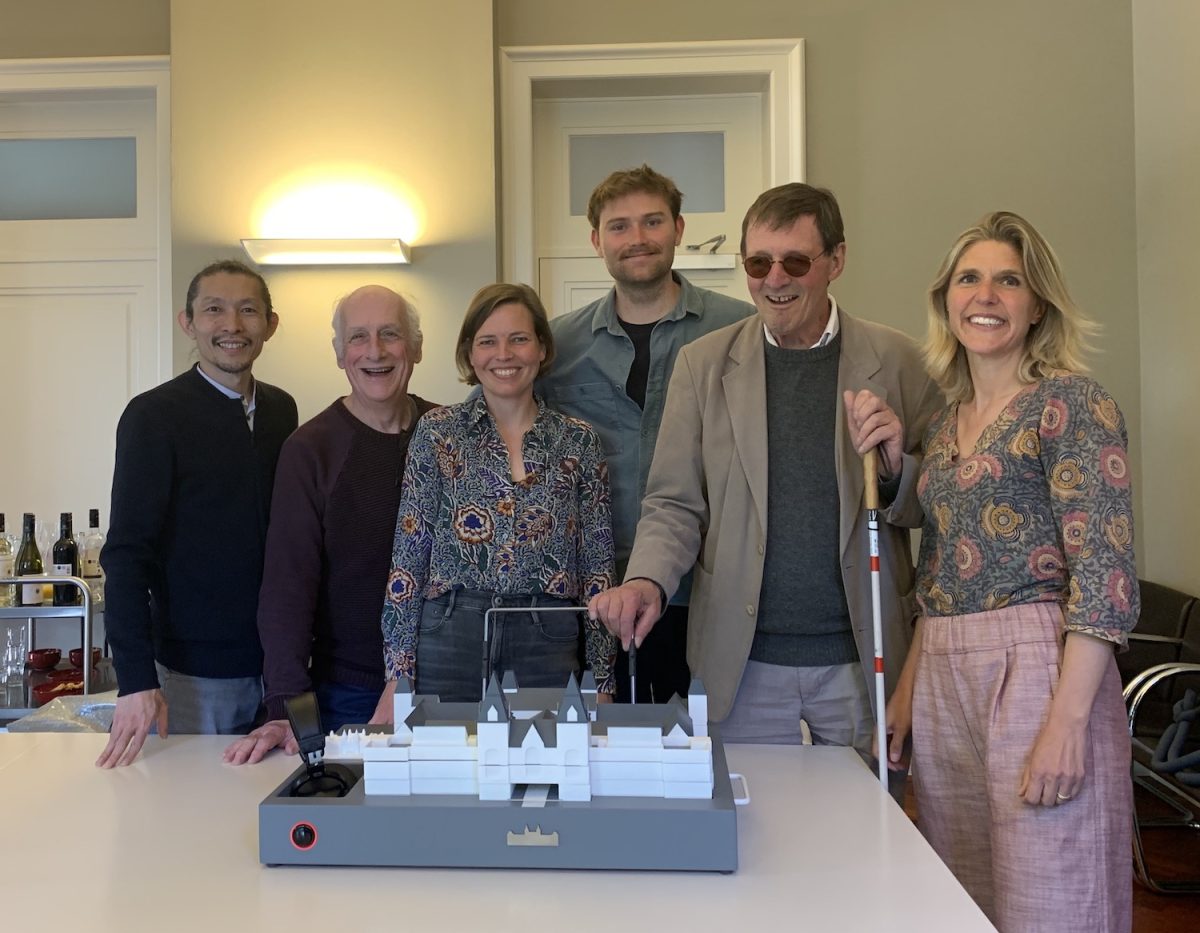 The production team of the Rijksmuseum (left to right): Kaita Shinagawa, Robert Bosch (sound engineer), Laura Ubachs (architect), Morris Adams (staff of Stichting Geluid in Zicht), Hannes Wallrafen, Cathelijne Denekam (Accessibility Manager of the Rijksmuseum) [Photo: Studio KU+]
The production team of the Rijksmuseum (left to right): Kaita Shinagawa, Robert Bosch (sound engineer), Laura Ubachs (architect), Morris Adams (staff of Stichting Geluid in Zicht), Hannes Wallrafen, Cathelijne Denekam (Accessibility Manager of the Rijksmuseum) [Photo: Studio KU+]





